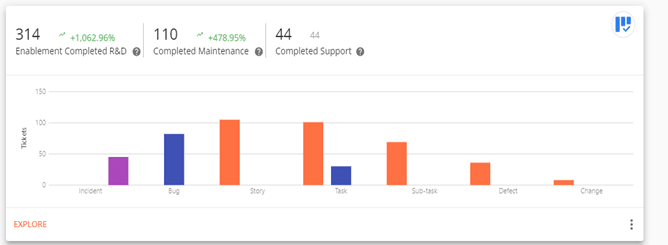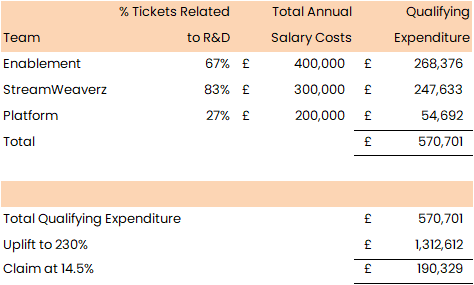Increase the accuracy and speed of your R&D Tax Credit calculation with Plandek dev team analytics
What are R&D Tax Credits?
Research & Development (R&D) tax credits are a (UK) government incentive designed to reward your company for investing in innovation. They are a valuable source of cash for businesses that invest in accelerating their R&D, hiring new staff and ultimately growing their business.
Whatever size or sector your company operates in, if you attempt to “resolve scientific or technological uncertainties” through “creating new products, processes or services” or “changing or modifying an existing product, process or service”, then it is likely you will be eligible for R&D tax credits.
What costs qualify for R&D Tax Credits?
The following costs would qualify for R&D tax credits in the UK:
Staff, including salaries, employer’s NIC, pension contributions and reimbursed expenses.
Subcontractors and freelancers. Materials and consumables, including heat, light and power, are used up or transformed by the R&D process.
Some types of software.
Payments to the subjects of clinical trials.
How to calculate R&D Tax Credits using Plandek?
Plandek is an analytics and performance improvement tool for software delivery technology R&D) teams.
Its principal use is to help technology teams understand better and analyse the software delivery process (from design through to the delivery of live software) to improve efficiency and accelerate the delivery of value.
As such, Plandek can also be used to help calculate your R&D Tax credit by providing detailed data on the first two cost elements in the section above:
related salary costs for staff;
and cost of subcontractors/freelancers.
Software development teams spend their time working on ‘tickets’ (increments of work tracked in Workflow Management tools like Jira or the Azure DevOps equivalent.)
Plandek offers instant visibility of all tickets and the proportion of completed tickets related to R&D.
This means a user can quickly and easily see the amount of time and, therefore, cost spent on qualifying R&D spend for any reclaim.
Indeed, here at Plandek, we use our own software to easily calculate the proportion of work done on R&D by our teams and then apply that to our salary costs.
Identifying qualifying teams
In the illustrative example below, we show how Plandek is used to identify the teams and individuals that have undertaken work that qualifies for an R&D Tax Credit.
Plandek shows the relevant data split out by Teams.
As you can see from the example graph above, the “Enablement” team (which consists of known individuals with known fully loaded salary costs) has completed 314 tickets that relate to R&D out of a total of 468 tickets during the tax year (the period for which the R&D Tax Credit is being applied for).
Other teams’ data can be easily split out and investigated further in the same way using Plandek.
The teams selected for the claim should be any team undertaking any R&D activity.
It is essential to include any R&D activity, no matter what size. Every little helps!
The number of tickets in each section is determined by the nature of work completed using data from Jira that is seamlessly imported into Plandek.
Calculation of the R&D Tax Credit Benefit
To fully calculate the benefit, salary information is needed. Salary information for each team member for the teams you are analysing should be included to maximise your claim.
Salary information should be sourced from your Finance Department.
Once salary data has been collected, the simple calculations below are done:
The number of tickets for R&D forms the basis of the calculation. Of the total tickets completed by “Enablement” (468), 314 relate to R&D, equating to 67% of the completed tickets.
This percentage is then applied to the total staff costs for the fiscal year for that team, and the process is repeated as necessary for your teams to give the total qualifying expenditure, which forms the basis for the claim.
As per UK HMRC, the qualifying expenditure should be uplifted to 230%, with the tax credit of 14.5% being payable on that amount.
These figures are correct for an SME as of December 2022 and are subject to change.
Conclusion
Using Plandek takes out the guesswork when calculating qualifying expenditures for R&D tax credits. There is no need to estimate percentages of time taken on specific projects or implement expensive and troublesome time-tracking processes.
Plandek is easy and quick to implement, offering end-to-end delivery and engineering metrics, analytics, and intelligent alerts to align and accelerate value delivery for your software teams.
R&D tax credit calculation is just another added benefit.
If you’re interested in learning more about how Plandek can help you with your R&D tax credit calculations, feel free to get in touch with us today.







Top comments (0)